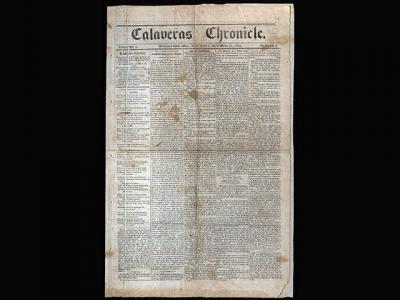The Calaveras Chronicle, Oct. 25, 1851

It has been said that there were three types of whalers: Those who wanted to make a career out of whaling, those who sought adventure, and those who probably had something they desperately needed to avoid on land. Whatever the case may have been, those looking to make a decent wage were often disappointed, as what they earned depended on the size of the ship’s catch. As such, they could return from years at sea and find very little money in their pockets if a voyage was unsuccessful.
That being the case, it’s understandable that many whalers sought to increase their fortunes by traveling to the West Coast during the California Gold Rush (1848 to 1855). The newspaper displayed here, The Calaveras Chronicle, is illustrative of this and why we have it in the East Hampton Library’s Long Island Collection.
Though the American whaling industry was at its peak during this time period, the prospect of gold offered a different kind of adventure to young men (especially if one could travel to California for free as a whaleman). In fact, upon reaching San Francisco many whalemen abandoned ship for the possibility of untold riches.
Located in the middle of the Sierra Nevada region, Calaveras County was home to at least two important Gold Rush towns, one being Mokelumne Hill, which is where The Calaveras Chronicle was founded in 1851. With some of the richest surface deposits in the state, it was one of California’s principal mining towns. By 1850, the population there was nearly 15,000.
The paper seen here is dated Oct. 25, 1851, making it the second issue. Within its pages you can find the East End names Weeks, Edwards, Halsey, Fowler, and Wade in advertisements listing them as “general dealers in groceries, provisions, and mining tools,” attorneys, barbers, or justices of the peace. It’s not known what ultimately became of these men, but Mokelumne Hill’s fortunes were short-lived, as its gold deposits ran out by the early 1860s.
—
Gina Piastuck is the department head of the East Hampton Library’s Long Island Collection.
